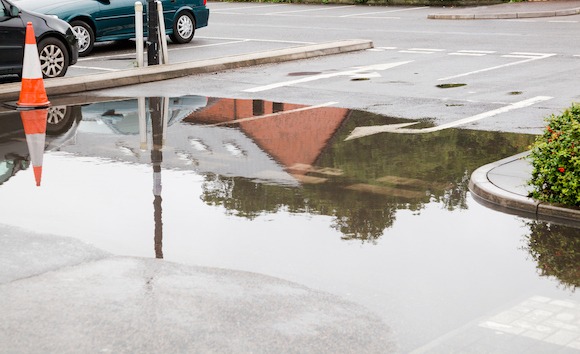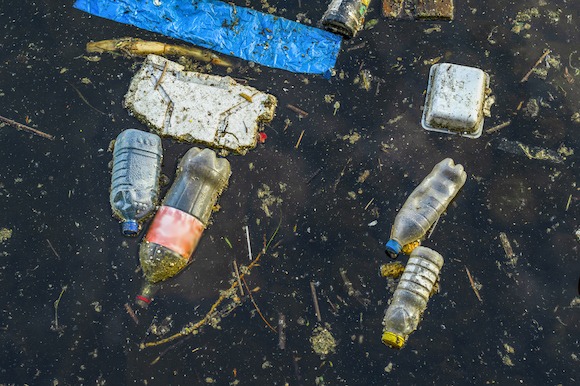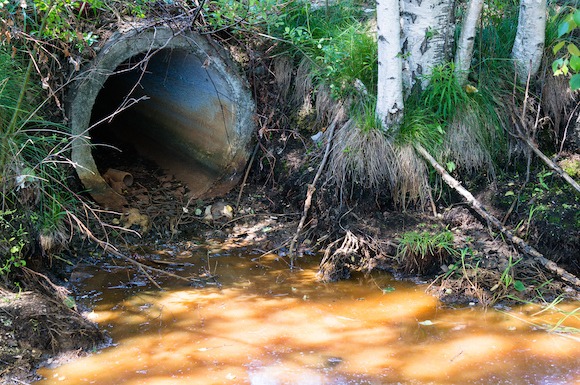Share This Story, Choose Your Platform!
Stormwater runoff is precipitation that flows across land, permeates into soil, merges into bodies of water, or evaporates back into the atmosphere. However, in urban environments, rainfall flows quickly across hard surfaces laden with pollutants. These contaminants are swept into waterways via drains and streams.
Improperly managed stormwater runoff can cause several problems for businesses, including property damage and regulatory violations.
Flooding: As stormwater flows over impermeable surfaces, such as roofs and pavement, large volumes of water can collect or flow rapidly, often causing property damage. Stormwater can also contribute to natural disasters by instantly raising water levels leading to severe flooding.
Water Pollution: Pollutants such as leaked automotive fluids, industrial waste, agricultural fertilizers, trash, animal waste, and refuse get picked up by urban stormwater flow and find their way, untreated, into local streams.
Stream Bank Erosion: As stormwater flows at unnaturally high speeds and volumes, it can cause severe degradation of shore banks. Rising waters can encroach on waterside property boundaries, destroy aquatic ecosystems, and create additional pollution from eroded sediment.
Human Health: Contaminants introduced to the natural water supply through stormwater runoff can adversely affect drinking water and the access to recreational water activities.



REGULATION & COMPLIANCE
As a result of the immense impact that stormwater runoff can have, the Environmental Protection Agency (EPA) developed the National Pollutant Discharge Elimination System (NPDES). This is a permit program, created in 1972 by the Clean Water Act (CWA), to address pollution by regulating sources that discharge pollutants to waters of the United States.
Under the CWA, Phase 2 of this program was established in 2003. It identified stormwater as a contributor to water pollution and mandated NPDES permits for land between 1 to 5 acres in size.
Most stormwater is conveyed through a Municipal Separate Storm Sewer System (MS4) and discharged into local water bodies. While generally owned by a state, local, or public entity, an MS4 is a system of drains, pipes, and ditches used to collect and transport stormwater. This water flow is typically discharged, untreated, into federally owned waters.
MS4 operators are required to get permits and develop Stormwater Control Measures (SCM), to limit the damaging effects of surface runoff. Failure to comply with the regulations results in a Notice of Violation (NOV).
An NOV informs the property owner or manager regarding a failed assessment, including a detailed observation of the property, non-compliance issues, assessed fines, and penalties. An inspection is typically conducted by local city or government official alerted through an unscheduled property check, distressed phone call from a stakeholder, or general observation. Unfamiliarity with environmental compliance laws is not an excuse for non-compliance.
Compliance with stormwater regulations is also strictly monitored during permitted construction projects. Sometimes violations are discovered after construction, requiring costly modifications. Common violations include:
- Failure of permit coverage
- Failure to include Stormwater Pollution Prevention Plans (SWPPP)
- Failure to implement SCM with essential maintenance and repair
- Failure to conduct or document inspections
- Illegal dumping or discharge
- Inadequate erosion controls
Violation notices typically include a one-time fine along with daily penalties for each subsequent day of non-compliance while the issue is remedied, sometimes reaching tens of thousands of dollars. The frequency and severity of these violations depend on the degree of impact to the environment along with the harm or potential harm to human health.
These situations can often be avoided with an annual inspection, costing as little as $100, and less costly preventative remediation.
ASSESSING STORMWATER ON YOUR PROPERTY
It is important to understand how stormwater is generated within and flows on your property. Here are the steps used by professionals to evaluate water generation, flow, and volume on a property.
Draw boundaries of the property. If not readily available, look up property tax assessment papers or deeds for basic property maps. Draw buildings and other features on the property. Be sure to designate:
- Impermeable areas and hard surfaces that prevent stormwater from soaking into the ground
- Lawn and landscaped areas
- Natural vegetation
- Water features (i.e., streams, wetlands, ponds, swimming pools)
Assess and map stormwater flow, identifying the directional flow of runoff on the property and any problems it may cause. Common issues include ponding or large puddles, damp basements, and soil erosion. Map the following:
- Roof downspouts
- Stormwater flow paths (using arrows for direction)
- Areas of ponding
- Ditches or gullies from soil erosion
Some of these common stormwater control measures may exist or be incorporated into a property:
- Retention or detention ponds
- Constructed wetlands
- Grass swales
- Sand filters
- Level spreaders
- Underground systems (popular in metropolitan cities due to the scarcity of space)
Drainage structures include:
- Inlet/Concrete flume
- Catch basin/Drop inlet
- Permeable pavement
- Curb inlets
- Trench drains (popular for retail assets)
- Culvert
- Headwall
- Flared-end section
- Dock drains
SITE-SPECIFIC OPERATIONS AND MAINTENANCE (O&M)
O&M plans are usually developed as part of a construction or remediation plan and filed with local municipality authorities. These consist of maintenance schedules, inspection requirements, maintenance easements, and descriptions of maintenance activities.
CONCLUSION
The most efficient ways to avoid NOVs and costly fines are to know your O&M agreement, consult with stormwater management professionals, communicate with regulatory bodies, set up maintenance programs, and schedule annual inspections.
Stormwater maintenance programs can also safeguard and extend the life of your investment while keeping long-term repair costs down. Be proud that you are making an impact on protecting the local environment and watershed.
About The Author: Pranav Heryani is an EHS & Sustainability Specialist. Among the next generation of environmental professionals, his projects have encompassed both local and international efforts toward green initiatives with practical sustainability for the commercial sector.
